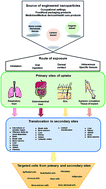Cell type specific cytoskeleton disruption induced by engineered nanoparticles
Abstract
One of the main concerns regarding nanomaterials is the cytotoxicity caused by engineered nanoparticles (NPs) after inhalation, oral or dermal routes of exposure, intravenous application, and delivery as debris from implants. Some of their effects are attributed to cellular uptake and others to NP interactions with the cell membrane in the absence of internalization, which can activate receptors and subsequent cell signaling. NP internalization is influenced by their chemical and physical nature. After cellular uptake, increased apoptosis, reactive oxygen species generation, cytokine release, cell cycle alterations, and cytoskeleton disruptions are among the most cytotoxic effects. Because the cytoskeleton has a central role in the cell architecture, the effects of NPs on the cytoskeleton network have been described frequently only as a cell shape parameter. However, the effects of NP exposure on the main cytoskeletal components, which have been less investigated, could be more relevant in terms of cell physiology. In this review, we discuss the effects of NPs, which can be categorized into metal oxides/metalloids/metals, carbon-based NPs, and organic-based NPs, on the cytoskeleton network according to the cell type of internalization. After exposure, NPs can be located in primary tissues and later translocated to secondary sites. Collectively, NPs can be internalized by epithelial cells, endothelial cells, fibroblasts, immune cells, brain cells, stem cells, bone marrow cells, and adipocytes. In all cases, it appears that NPs disrupt the cytoskeleton at various levels, but less attention has been focused on the physiological consequences linked to such disruptions. Therefore, we suggest that the effects beyond shape modifications induced by NP uptake could be related to alterations in the physiology of each cell type.

- This article is part of the themed collection: Nanomaterials in air


 Please wait while we load your content...
Please wait while we load your content...